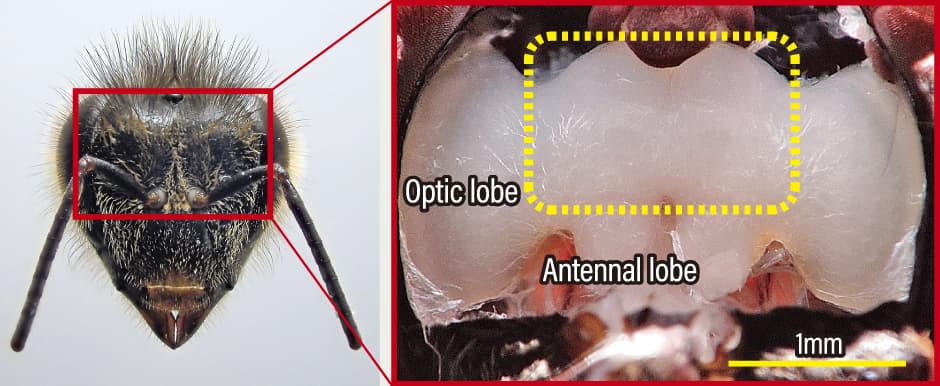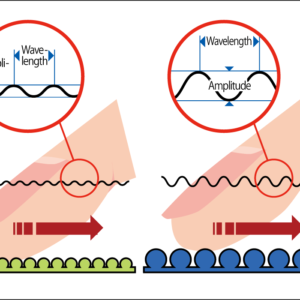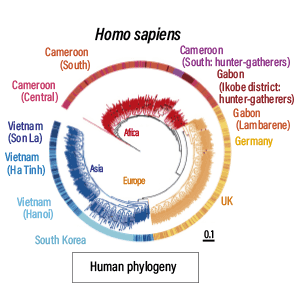The relationship between honeybees and humans has continued unbroken since ancient times. Beekeeping —— also known as apiculture —— was already being carried out in ancient Egypt, more than 4,000 years ago. While the substances produced by honeybees have been prized through the ages as precious sources of nutrition, today honeybees are renowned as insects that are also essential to the production of agricultural crops, due to their role as pollinators that carry pollen between plants. At the same time, there are many as-yet-unexplained mysteries concerning these highly evolved social insects, which display diverse and complex social behaviors consisting of ingenious communication, such as their figure-eight waggle dance. Hopes for future research are high.
Special Feature 1 – The World of Honeybees Social insects essential to humanity
composition by Yuko Watanabe
Honeybees not only provide us with nature’s bounty in the form of sweet, tasty honey, but are also important insects that play an essential role in our lives as pollinators of agricultural crops, carrying pollen from one plant to another. Despite their small size, honeybees demonstrate highly advanced functions comparable to mammals; centered on one queen bee, colonies of anywhere between a few thousand to tens of thousands of honeybees will act just like a single individual.
Genome of the Japanese honeybee successfully decoded
With its neat rows of tiny hexagons, honeycomb achieves a high level of strength using minimal material. The center of the beehive, where larvae are raised, is maintained at around 34°C by means of meticulous management of the temperature: when it is cold, the worker bees contract the flight muscles in their thorax to generate heat, and when it is hot, they fan their wings to ventilate the hive and cause accumulated water to evaporate, thereby using the heat of vaporization to lower the temperature. Honeybees also undertake thorough hygiene management, cleaning the inside of the hive to prevent infectious diseases. They communicate closely using a variety of methods, including pheromones and other chemical substances, and a dance language, most notably the famous figure-eight waggle dance.
The base sequence of the European honeybee (Apis mellifera) genome was determined in 2006, making it the third insect to have its full set of genetic information sequenced. In 2019, success was achieved in decoding the genome of the Japanese honeybee (Apis cerana japonica), a wild species native to Japan. As a result, efforts to shed light on the remarkable functions of the honeybee progressed further.
Honeybee colonies are composed of a single queen bee, anywhere between a few thousand and tens of thousands of worker bees, and drones that emerge during the breeding season (Figure 1). Larger than a worker bee, and with a longer torso due to its well-developed ovaries, a queen bee has the ability to lay more than 1,000 eggs per day when conditions are good, and has a life expectancy estimated at two to three years. Worker bees have lost virtually all their ability to lay eggs, but genetically speaking, they are female and equate to daughters of the queen bee; these daughters perform various roles to maintain the colony. However, with a life span of around a month and a half, they hand over their roles to subsequent generations of younger sisters born after them. The number of drones born in the breeding season, which runs from spring until summer, accounts at its highest level for only about 10% of the colony as a whole. They are slightly larger than a worker bee and have large, well-developed compound eyes, which, as honeybees mate in midair while flying, make it easier to spot new queen bees as they fly. Specialized for reproduction, drones are not involved in the work of a colony in the same way as worker bees, and they cease to be produced once the breeding season is over, so they disappear entirely from hives before winter arrives.

Figure 1. The two species of bees that live in Japan<Left> The Japanese honeybee (Apis cerana japonica) is a native species. Circled in yellow is the queen bee, surrounded by worker bees. It is somewhat blacker than the European honeybee (Apis mellifera). <Middle> The European honeybee, which was first introduced to Japan in the Meiji period. They are used in beekeeping, due to their excellent nectar-gathering ability. Circled in yellow is the queen bee. <Right> Circled in yellow is a European honeybee drone.
Queen bee larvae are fed only royal jelly
The key players in a honeybee colony are thus the queen bee and the worker bees. Although they share the same genetic information, they differ completely in terms of such attributes as shape, role, and life expectancy. The phenomenon whereby individuals of the same species and sex differentiate into individuals with reproductive ability and infertile individuals is called caste differentiation.
The question of whether a larva will become a queen or a worker bee is determined by the content and quantity of the food it received from the time it is born. Queen bee larvae are fed nothing but a milky secretion called royal jelly, which is highly nutritious and contains a mixture of substances, including proteins synthesized in the hypopharyngeal gland located in the heads of the worker bees that raise the larvae, along with lipids synthesized in their mandibular glands. On the other hand, while worker bee larvae, similarly to queen bee larvae, receive the milk produced by nurse worker bees until the third day after hatching, pollen and honey are mixed into their food thereafter. There are also differences between larvae destined to become queen bees and larvae set to be worker bees in terms of the quantity of food provided to them. Studies in which larvae were artificially raised to produce queen bees and worker bees have shown that larvae fed more milk than they can eat become queen bees, while larvae fed an amount of milk about equivalent to their weight become worker bees. This astonishing phenomenon that occurs in bees could be likened to a situation in which differences in the quality and quantity of milk that a human baby received in infancy resulted in some humans living to 1,000 years old and others to just 80.
So, why does caste differentiation occur as a result of differences in the content and quantity of feed provided at the larval stage? The first step toward shedding light on this mechanism was the aforementioned decoding of the honeybee genome, which determined the base sequence of all honeybee genes. Widely observed in organisms, DNA methylation is a mechanism for regulating the expression of genes without altering the base sequence; in mammals, it is associated with many crucial phenomena, including birth, aging, disease, and learning. However, as DNA methylation does not occur in fruit flies (Drosophila) —— the insects regarding which research at the genetic level is most advanced —— it had been thought that insect DNA was not methylated. But in fact, it became apparent that honeybees have the genes required for DNA methylation. As a model invertebrate species in the field of epigenetics, which involves studying DNA methylation and other such mechanisms, honeybees are contributing to efforts to unravel various biological mechanisms.
To identify the characteristics of DNA methylation in honeybees, our research team compared queen bees with worker bees, focusing on the gene carrying information regarding hexamerin 110, which is a storage protein. We found a tendency for queen bees to have a lower degree of methylation. DNA methylation is known to have a suppressive effect on gene expression. The results can be interpreted to mean that DNA methylation is kept at a low level in queen bees, causing gene expression to be intensified. There are hopes that future advances in research will reveal how differences in the food provided to honeybee larvae affect DNA methylation and elicit caste differentiation.
In a honeybee colony, whereas queen bees and drones are specialized for reproduction, worker bees engage in age polyethism, in which the various roles they carry out to maintain the colony are allocated according to the number of days that have passed since they emerged (Figure 2).
 (Illustration: Uta Asaga)
(Illustration: Uta Asaga)
Figure 2. Age polyethismThe life expectancy of a worker bee is about a month and a half, and their behavior changes as they grow older. They start by cleaning cells, and then devote themselves to such activities as caring for larvae and the queen bee, hive building, honey storage, and pollen packing. Once elderly, they go out foraging.
After developing in its cell from a larva into a pupa, the worker bee emerges, and the first thing it does is to clean its own cell and others. Between day 3 and day 10 or thereabouts, the worker bee tends to the larvae, and subsequently takes charge of tasks including hive building, storage, and guarding the hive against enemies. It is about two to three weeks after reaching adulthood that worker bees leave the nest to work as foragers, gathering nectar and pollen.
Foragers that have returned to the hive carrying nectar gathered from flowers pass the nectar mouth to mouth to the bees in charge of storage stationed near the hive entrance, then go back out to forage. The job of house bees is to concentrate the nectar and process it into honey. The job of a forager is a dangerous one. There are many natural predators outside the hive, while sudden downpours can prevent them from returning to the hive. The division of roles is very rational: young bees carry out safe tasks, such as raising larvae and storage, while older, veteran bees take on duties with a high risk of death.
Social behavior supported by communication
Insects that lead solitary lives must carry out all the tasks required to live on their own. Honeybees, on the other hand, divide up the labor of reproduction and work other than reproduction between the queen bee and the worker bees; in addition, the worker bees allocate the various tasks required for colony management on the basis of age. For example, the task of raising larvae is assigned to young bees, while the task of foraging is allocated to elderly bees. Thinking that we might be able to tap into such distinctive features of honeybees to explore the molecular basis of the brain functions controlling specific behaviors, we undertook a study in which we compared nurse bees with foragers.
In the center of insect brains are regions called mushroom bodies (Figure 3), so called because of their mushroom-like shape. These mushroom bodies serve as a higher-order center that integrates and outputs information sensed from the outside world. When we extracted the mushroom bodies from honeybee brains and conducted whole genome analysis of the methylation of extracted DNA, differences in the patterns of DNA methylation between nurse bees and foragers came to light. This suggested that an epigenetic adjustment mechanism comes into play not only in caste differentiation, but also in age polyethism.

Figure 3. The honeybee brainWe extracted the mushroom bodies (area within the yellow dotted line in the right-hand photograph) from the brains of nurse bees and foragers, and checked for differences in methylation patterns of the extracted DNA. We discovered that an adjustment mechanism that controls specific behaviors comes into play.
The diverse and complex social behaviors of honeybees are supported by close communication between individuals. Dance language is one communication tool; the figure-eight waggle dance used to communicate information about feeding grounds is famous, but honeybees also employ various other types of dance to convey information. I would like to introduce the results of two studies conducted by undergraduates at Tamagawa University College of Agriculture.
One is a study concerning abdomen shaking. Honey production is carried out by means of cooperation between foragers that gather nectar and storage bees that process the nectar into honey. The foragers fly around outdoors, collecting nectar, which is subsequently received by storage bees inside the hive; these storage bees then deposit the nectar into cells and process it into honey. The balance between foragers and storage bees is crucial to the efficient functioning of this division of labor.
For example, if there are few foragers when many flowers are in bloom, honeybees will miss out on a precious opportunity. To ensure this does not occur, at times when it seems likely that a great deal of nectar will be able to be collected, foragers will shake their abdomens to convey the information that the number of foragers should be increased. Foragers that have returned to the hive crawl on top of young house bees that have never yet been out foraging, cling tightly to them, and shake their abdomens up and down for a second or two. They then move on the honeycomb and repeat the same shaking on other house bees. This action appears as though the foragers are shaking the house bees’ bodies in an effort to hurry something up. In this mechanism, house bees that have received the shaking signal move close to the hive entrance, and then go out to forage once stimulated by the figure-eight waggle dance that conveys information about feeding grounds.
There are two species of honeybee in Japan: the native Japanese honeybee and the European honeybee, which was introduced from the West during the Meiji period (1868-1912) for the purpose of beekeeping. European honeybees are better honey producers than Japanese honeybees. Research into European honeybees is also more advanced, so abdominal shaking had only been investigated in that species. Accordingly, we observed abdominal shaking in Japanese honeybees and found that, whereas European honeybees cling to other bees while shaking their abdomens, some Japanese honeybees clung to the honeycomb while performing the action. We believe that, whereas European honeybees encourage individual bees to mobilize, Japanese honeybees might be communicating with multiple individuals around them via the vibrations transmitted through the honeycomb.
The tremble dance communicates a variety of information
The other study relates to something called the tremble dance. If a large amount of nectar has been gathered, but the number of storage bees is not increased, foragers wanting to pass on their nectar are kept waiting in the hive, which is inefficient. European honeybees are known to perform a tremble dance to encourage nurse bees to take on storage duties. In this dance, the bees make their bodies tremble from side to side while walking on the honeycomb; we confirmed that Japanese honeybees also perform a similar dance. Although we observed it only a few times during the experiment, we confirmed that Japanese honeybees also perform the tremble dance, so we believe that, just as in European honeybees, this tremble dance serves to transmit information for the purpose of increasing the number of storage bees.
A study led by one of the foremost U.S. experts in the field of honeybee research, Dr. Thomas D. Seeley, ascertained through painstaking fieldwork that dances are used to communicate candidate sites when a swarm is deciding on its new abode, and that a democratic decision-making process takes place when selecting the best nesting site.
When spring arrives, a new queen bee is raised in the hive, but there can only be one queen in a single hive. Accordingly, the original queen bee leaves, accompanied by around half the worker bees in a swarm, ceding the hive to the new queen. The swarm will temporarily gather on a tree branch or similar, forming a swarm ball (Figure 4) that remains there for anywhere between a few hours and several days while the bees search for a new home. About 200-300 scout bees fly around the area, looking for a good place to call home, such as a comfortable hollow; once they identify a good site, they return to the swarm ball and perform a figure-eight waggle dance to inform the other bees of the candidate site. The other scout bees also perform a figure-eight waggle dance to communicate the location of candidate sites they have found elsewhere.

Figure 4. A swarm ball formed temporarily on a treeA bee swarm occurs when the old queen bee leaves the hive, accompanied by half the worker bees. Scout bees search for a new home and a democratic decision is taken regarding the best nesting site. This perfectly demonstrates the astonishing communication skills of honeybees.
The better the candidate site, the stronger the scout bees will dance, whereas they will not dance strongly for a location that is not very good. In this mechanism, a stream of other scout bees stimulated by a strong dance then visit the candidate site in question, and most of them will steadily congregate at the best site. As a result, the scout bees choose the best new abode from several candidate sites, and the swarm ball will then take off en masse to complete the move to their new home.
A honeybee’s brain measures just 1×2×0.5 mm. However, this tiny brain is packed with outstanding functions. What is more, honeybee society is able to make decisions as a collective through communication among numerous brains.
With such distinctive characteristics as caste differentiation, age polyethism, and their means of communication, honeybees are precious creatures that never cease to captivate researchers. Going forward, we would like to focus more closely on the various mechanisms of honeybees, while also undertaking fieldwork in the verdant region in which our university is located. Among others, we would like to examine the methods used by the Japanese honeybee to protect itself from attacks by its natural predator, the Asian giant hornet (Vespa mandarinia).




















